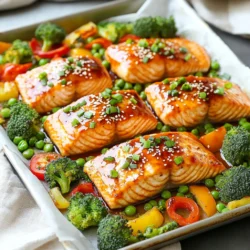
Savory Sheet Pan Teriyaki Salmon & Veggies
A delicious and easy sheet pan meal featuring salmon fillets and colorful vegetables, all coated in a flavorful teriyaki sauce.
Ingredients
- 4 fillets salmon
- 2 cups broccoli florets
- 1 cup bell peppers (mixed colors), sliced
- 1 cup snap peas
- 3 tablespoons teriyaki sauce
- 2 tablespoons olive oil
- 2 teaspoons grated ginger
- 2 cloves garlic, minced
- Salt and pepper to taste
- Sesame seeds (for garnish)
- Chopped green onions (for garnish)
Instructions
- Preheat your oven to 400°F (200°C).
- In a small bowl, whisk together the teriyaki sauce, olive oil, grated ginger, minced garlic, salt, and pepper.
- Place the salmon fillets on a large sheet pan lined with parchment paper. Sprinkle the salmon with salt and pepper, then brush generously with the teriyaki sauce mixture.
- In a mixing bowl, combine the broccoli, sliced bell peppers, and snap peas. Drizzle with a little olive oil, and season with salt and pepper. Toss until well coated.
- Arrange the vegetable mixture around the salmon on the sheet pan. Drizzle any remaining teriyaki sauce over the veggies.
- Bake in the preheated oven for 15-20 minutes, or until the salmon is cooked through and flakes easily with a fork.
- Remove from the oven and let cool slightly. Garnish with sesame seeds and chopped green onions before serving.
Notes
Serve directly from the sheet pan for a rustic feel, or plate each salmon fillet with a colorful assortment of veggies.